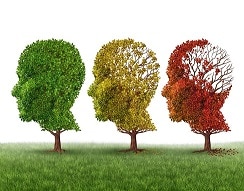
If you’re an aging adult or you work with the aging population regularly, it’s important that you know the warning signs of Alzheimer’s disease. According to the Alzheimer’s Association, 5.7 million Americans are living with Alzheimer’s, and that number is expected to rise to some 14 million by the year 2050. Because of these staggering numbers, Alzheimer’s ranks as the sixth leading cause of death in the U.S. But here’s the silver lining: Early and accurate diagnosis of the condition is more attainable than ever, and early treatment translates to major benefits for those who suffer from or are at-risk of developing the disease.
Unfortunately, there’s no cure for Alzheimer’s nor any treatment that can alter the underlying course of the disease, but early detection is still vital. It allows seniors to make important legal, financial and medical plans while still capable, and it has the capacity to reduce costs by about $7.9 trillion, according to the Alzheimer’s Association. Parents, friends, doctors and senior caregivers can all play a role in spotting the differences between normal cognitive aging and Alzheimer’s disease, and it just might improve your loved one’s quality of life by a whole lot.
The Alzheimer’s Conundrum
There’s an innate issue with recognizing the symptoms of Alzheimer’s disease: They resemble normal aging, and we all age. The truth is that everyone—whether suffering from Alzheimer’s or not—experiences some level of cognitive deterioration with age. Most people will have difficulty processing information as they get older, which means we might have trouble remembering things, recalling information or speaking as coherently as we once could. These things don’t necessarily indicate that Alzheimer’s is on the horizon, however.
Alzheimer’sis a form of dementia, but not all dementia sufferers are Alzheimer’s sufferers. Whereas Alzheimer’s is believed to be caused by a buildup of toxic proteins in the brain, dementia can be caused by a range of conditions or simply aging. Still, Alzheimer’s is the most common form of dementia, so it’s very important to understand the warning signs as part of a holistic senior care approach. Let’s take a deep dive into the different kinds of cognitive aging to understand how Alzheimer’s differs from normal signs of aging.
From Normal Aging to Alzheimer’s
· Memory Loss—The Alzheimer Society of Canada points out that over 40 percent of people over the age of 65 experience some form of memory loss, which makes spotting the differences between normal aging and Alzheimer’s rather difficult. Memory loss is, indeed, one of the most common, early signs of Alzheimer’s disease. The primary difference between normal memory loss and Alzheimer’s is that Alzheimer’s sufferers typically can’t recall recently-learned information or events, whereas those experiencing normal cognitive aging might not remember things that occurred a year or more ago.
· Everyday Tasks—The inability to recall words, actions or plans can seriously disrupt one’s ability to complete everyday tasks. For example, a person exhibiting early signs of Alzheimer’s might find it difficult or impossible to find a familiar location or to remember how to perform a recently-learned task. On the other hand, those experiencing normal aging may need assistance with certain tasks, but typically have the ability to retain some or all new information.
· Language—Alzheimer’s has a significant effect on language and writing. Some early signs of Alzheimer’s include stopping in the middle of a conversation, regularly repeating what was already said or struggling with vocabulary. People with Alzheimer’s may also have difficulty remembering the names of certain items, people or places. Occasionally not being able to find the right word is a normal age-related change and isn’t necessarily a cause for concern.
· Vision—Another way that Alzheimer’s manifests itself in sufferers is through vision problems. It may cause an individual to have difficulty with mobility and getting around safely. Those who suffer from Alzheimer’s disease may experience visual impairment associated with depth perception, color perception, motion blindness and contrast sensitivity. People who are aging normally are also likely to suffer from vision problems, but they’re often attributed to easily diagnosable conditions such as cataracts.
· Other Factors—The Alzheimer’s Association also points out that sufferers may have difficulty completing tasks—in fact, they might stop in the middle of a formerly routine or familiar activity and abandon the task all together—as well as a tendency to misplace things. Additionally, Alzheimer’s sufferers may experience changes in their ability to solve problems, plan or strategize. Simple tasks such as cooking dinner from a recipe, balancing the checkbook or deciding who to call for assistance are complicated or impossible.
· Diagnosis—At the end of the day, the best way to find out whether you or a loved one is suffering from Alzheimer’s is to seek a proper diagnosis. With that being said, Alzheimer’s diagnoses are anything but straightforward. There’s no single test used to make an official diagnosis. A physician will evaluate a patient’s entire medical history, mood status, physical and neurological state and other factors before diagnosing the disease. Because many conditions can cause dementia-like symptoms—including depression, drug interactions, alcohol use and thyroid problems—a doctor’s evaluation is extremely important.
How You Can Help Aging Relativesor Patients
A study from the Washington University School of Medicine found that family members and friends may be better judges of early Alzheimer’s disease than standard memory tests. As a major piece of the diagnosis puzzle, the best thing that you can do to assist aging relatives or patients is to understand when it’s normal aging or a sign of Alzheimer’s. If you believe that you or a loved one is suffering from this disease or may develop it in the future, be sure to relay all information and symptoms to a physician on your next visit. Early detection can make a big difference in care and outcome.